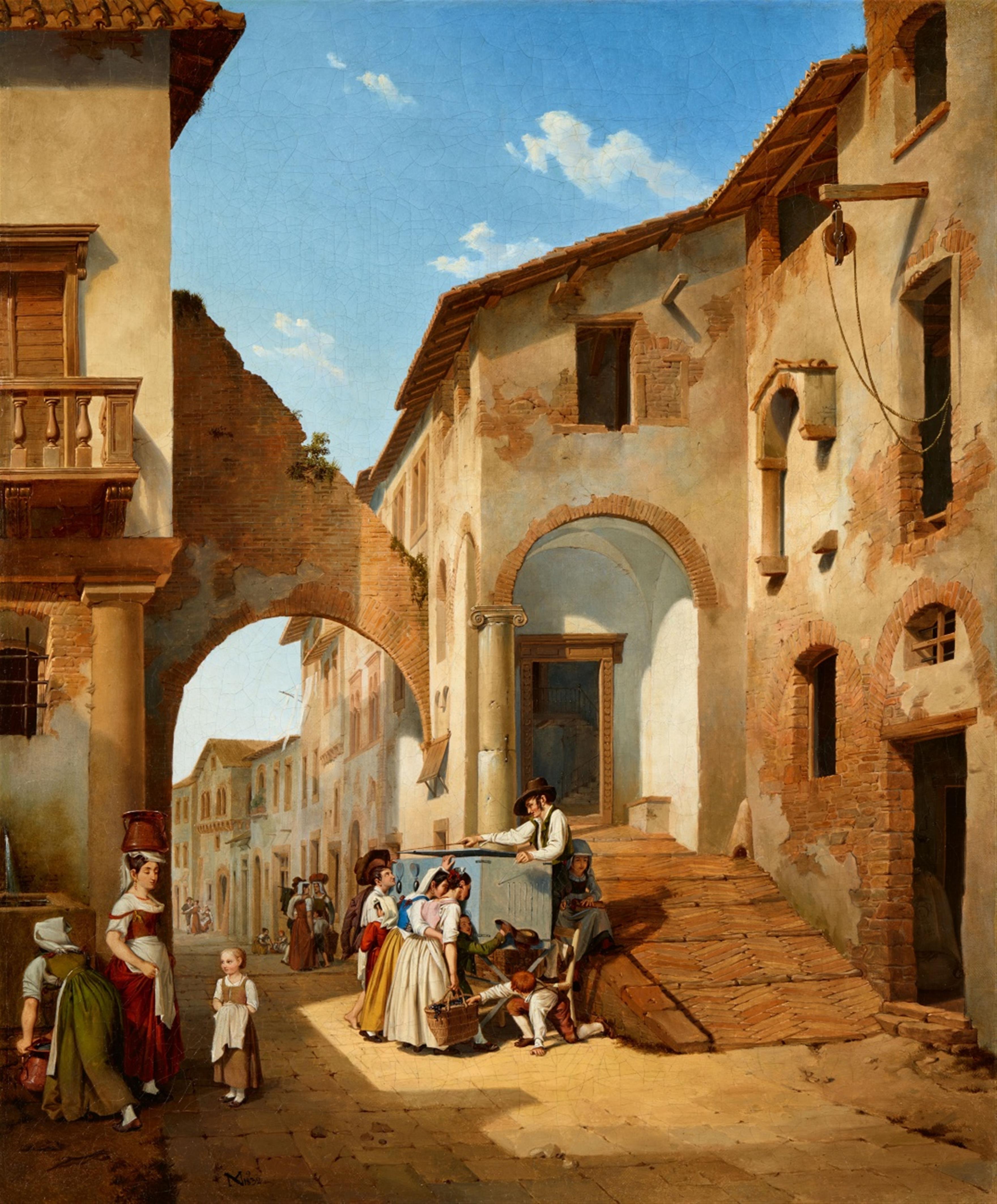Michael Neher
A Street in Tivoli
Oil on canvas. 57 x 48 cm.
Monogrammed and dated lower left: MN 1832.
Italy held a powerful fascination for many artists throughout the late 18th and early 19th centuries - especially the German Romantics and Nazarenes, from Hackert to Schadow and Nerly to Michael Neher. Born in Munich in 1798, Neher studied at the Royal Academy of Fine Arts in Munich under Mathias Klotz and Angelo I. Quaglio as of 1813 and spent several years in Italy as of 1819. He settled in Rome in 1823, where he made a name for himself as a skilful painter of landscapes and architecture, and became acquainted with fellow architectural painter Heinrich Maria von Hess. Even after his return to Germany in 1825, Neher still painted Italian motifs, as shown by this impressive example of his romantic and narrative genre painting, "A Street in Tivoli" from 1832.
Neher transforms an atmospheric architectural painting into a classic Biedermeier veduta presenting scenic, sun-filled corner of a piazzetta in Tivoli with a view of a broad alleyway. The meticulously detailed depiction of the facades allows the viewer to fully admire the classical architecture, and the scene is enlivened by groups of figures gathering curiously around a peep box, a typical scene from everyday life in this popular tourist destination to the Eternal City. The artist is equally meticulous in his depiction of the contemporary costumes as he is in showing the antics of the mischievous children.
"A street in Tivoli" is the second version of this motif. King Friedrich Wilhelm III of Prussia acquired the first from 1830 in the same year at an exhibition at the “Münchner Kunstverein”, and it adorned Potsdam Palace from 1831 onwards (see: Ausstellung Deutscher Kunst aus der Zeit von 1775-1875, Königliche Nationalgalerie, Berlin 1906, no. 452). This painting was destroyed during the Second World War (see: Zerstört - Entführt - Verschollen. Die Verluste der preußischen Schlösser im Zweiten Weltkrieg, ed. by Stiftung Preussische Schlösser u. Gärten Berlin-Brandenburg, p. 338, no. GK I 4346).
The present work was exhibited at the “Münchner Kunstverein” in 1832 and at the “Kunstverein Hannover” the following year, where it was purchased for a raffle (F. Boetticher, op. cit. And the exhibition lists of the “Kunstverein München 1832“ and the “Kunstverein Hannover“ in 1833). The winner of this raffle, and with it the location of this painting until it appeared at auction again in 1998, remain a mystery.
Michael Neher, who was trained in the Neoclassical style but influenced by the Nazarenes, was commissioned by King Ludwig I shortly after painting this work to create the murals of Hohenschwangau Castle (1834 to 1837) in collaboration with the important Romantic architectural painter Domenico Quaglio. The King acquired the castle as “Burg Schwanstein” in 1832 and renamed it. Thus, Neher was also among the circle of great artists assembled by Prince Ludwig, later King Ludwig of Bavaria, to carry out his commissions for paintings and architectural works.
This painting will be included in the catalogue raisonné of Michael Neher's works currently being prepared by Günther Meier.
Provenance
Private ownership, Berlin. - Sotheby´s Munich 30.6.1998, no. 27. - Private ownership, Belgium.
Literature
Friedrich Boetticher: Malerwerke des Neunzehnten Jahrhunderts, 1941 edition, vol. II, p. 133, no. 8.
Exhibitions
Kunstverein München 1832. - Kunstverein Hannover 1833.

